Aeroplan prices itineraries according to a complex set of rules. Applying your knowledge of these rules can enhance your trip, save you points, and help you stretch out the value of your points to the maximum.
Let’s take a look at the practice of strategic bound breaking with Aeroplan in more detail.
What Is Strategic Bound Breaking?
Aeroplan has a series of rules that determine where a “one-way bound” begins and ends, and thus how much a given itinerary will cost.
In some cases, the structure of the distance-based Flight Reward Chart causes the pricing to vary depending on where you “break the bound”.
In other words, there are some cases where you can strategically choose to begin or end your one-way bound, in an effort to keep the distance flown in a lower distance band, which results in your itinerary costing fewer Aeroplan points.
A Few Examples
Let’s look at some examples to spell out how strategic bound breaking could be beneficial to you.
Example 1: Choosing Your Stopover Strategically
Consider the example of a Thunder Bay resident who wants to visit Istanbul and Tel Aviv on the same trip, flying in business class. She puts together the following proposed itinerary:
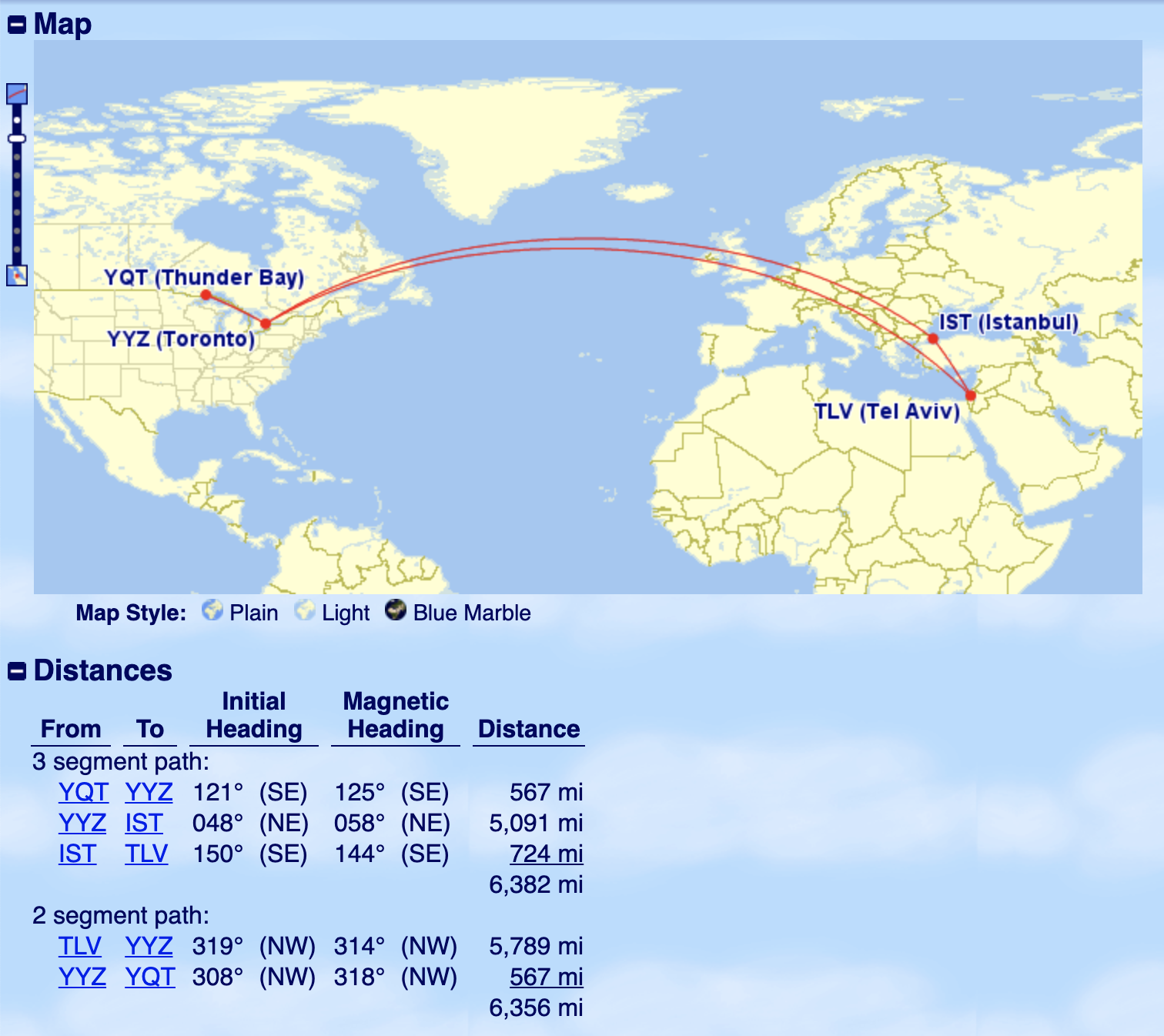
- Thunder Bay–Toronto–Istanbul (stopover)–Tel Aviv, on Air Canada and Turkish Airlines
- Tel Aviv–Toronto–Thunder Bay, on Air Canada
To keep things simple, let’s assume that our traveller is able to find pricing for the Air Canada flights at the lower end of the dynamic pricing range.
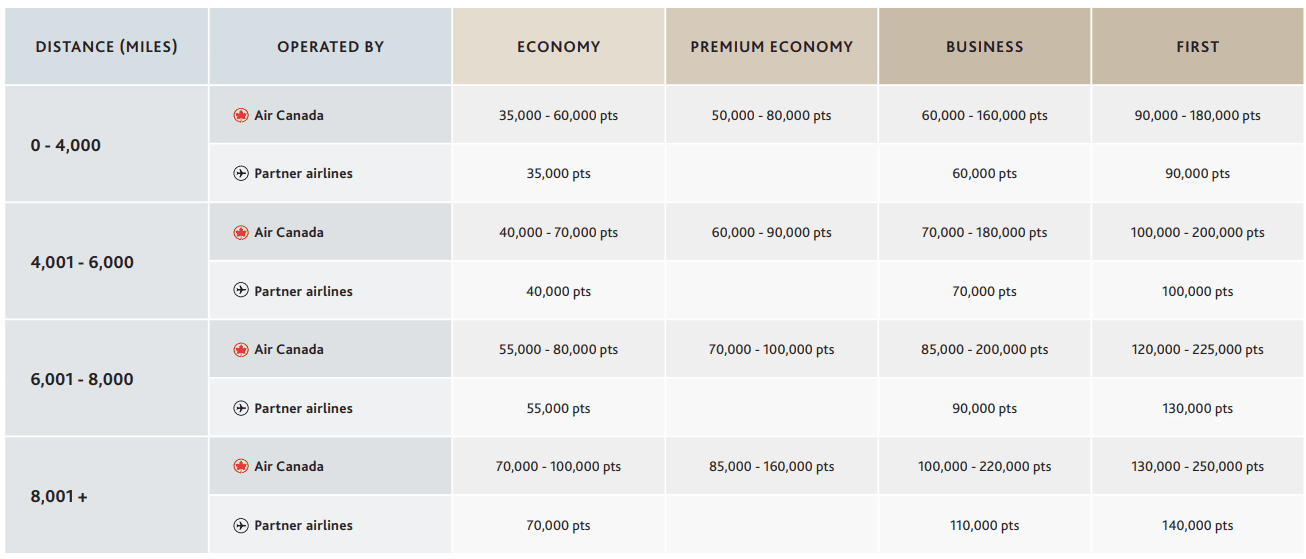
Looking at the “Between North America–Atlantic zones” chart, our traveller would calculate the pricing for this redemption as follows:
- Outbound journey of 6,382 miles: This falls into the third distance band of 6,001–8,000 miles, and would therefore cost 90,000 Aeroplan points in business class
- Return journey of 6,356 miles: This also falls into the third distance band of 6,001–8,000 miles, and would therefore cost 90,000 Aeroplan points in business class
- Adding a stopover in Istanbul costs an additional 5,000 Aeroplan points
- Total of 185,000 Aeroplan points
However, imagine that we were to “break the bound: in Istanbul instead. The proposed itinerary would look as follows:
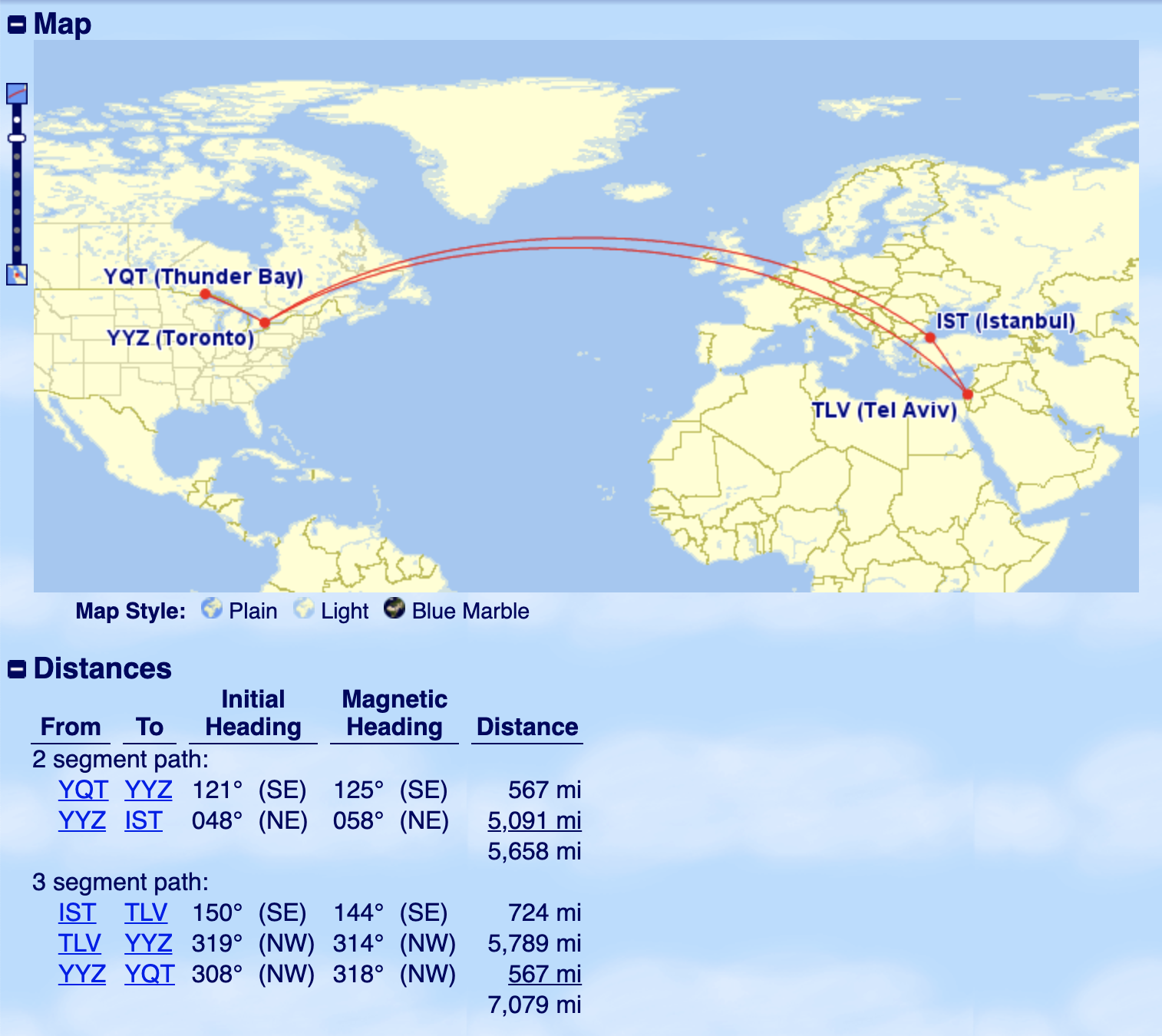
- Thunder Bay–Toronto–Istanbul, on Air Canada and Turkish Airlines
- Istanbul–Tel Aviv (stopover)–Toronto–Thunder Bay, on Turkish Airlines and Air Canada
Looking again at the North America–Atlantic chart, our traveller would calculate the pricing for this redemption as follows:
- Outbound journey of 5,658 miles: This falls into the second distance band of 4,001–6,000 miles, and would therefore cost 70,000 Aeroplan points in business class
- Return journey of 7,079 miles: This falls into the third distance band of 6,001–8,000 miles, and would therefore cost 90,000 Aeroplan points in business class
- Adding a stopover in Tel Aviv costs an additional 5,000 Aeroplan points
- Total of 165,000 Aeroplan points
As you can see, the two trips are virtually identical, but our traveller can potentially save 20,000 Aeroplan points by being strategic about where to “break the bound”.
Similar logic can be applied towards basically any round-trip booking that includes one stopover, where the flown distance in either direction comes very close to one of the distance thresholds on the chart.
Note that in practice, the Aeroplan contact centre’s booking system is likely to automatically choose Istanbul as the stopover point if you were to feed the agent the entire itinerary all at once.
To strategically break your bound, you’ll want to book two separate one-way awards with the agent: the first from Thunder Bay to Istanbul, and the second returning from Istanbul with a stopover in Tel Aviv.
Example 2: Booking as Two Separate Awards
The other angle where “strategic bound breaking” comes into play is when we think about whether it might be advantageous to book a single award as two separate awards instead.
Consider something like Dublin–Frankfurt (stopover)–Beijing in business class.
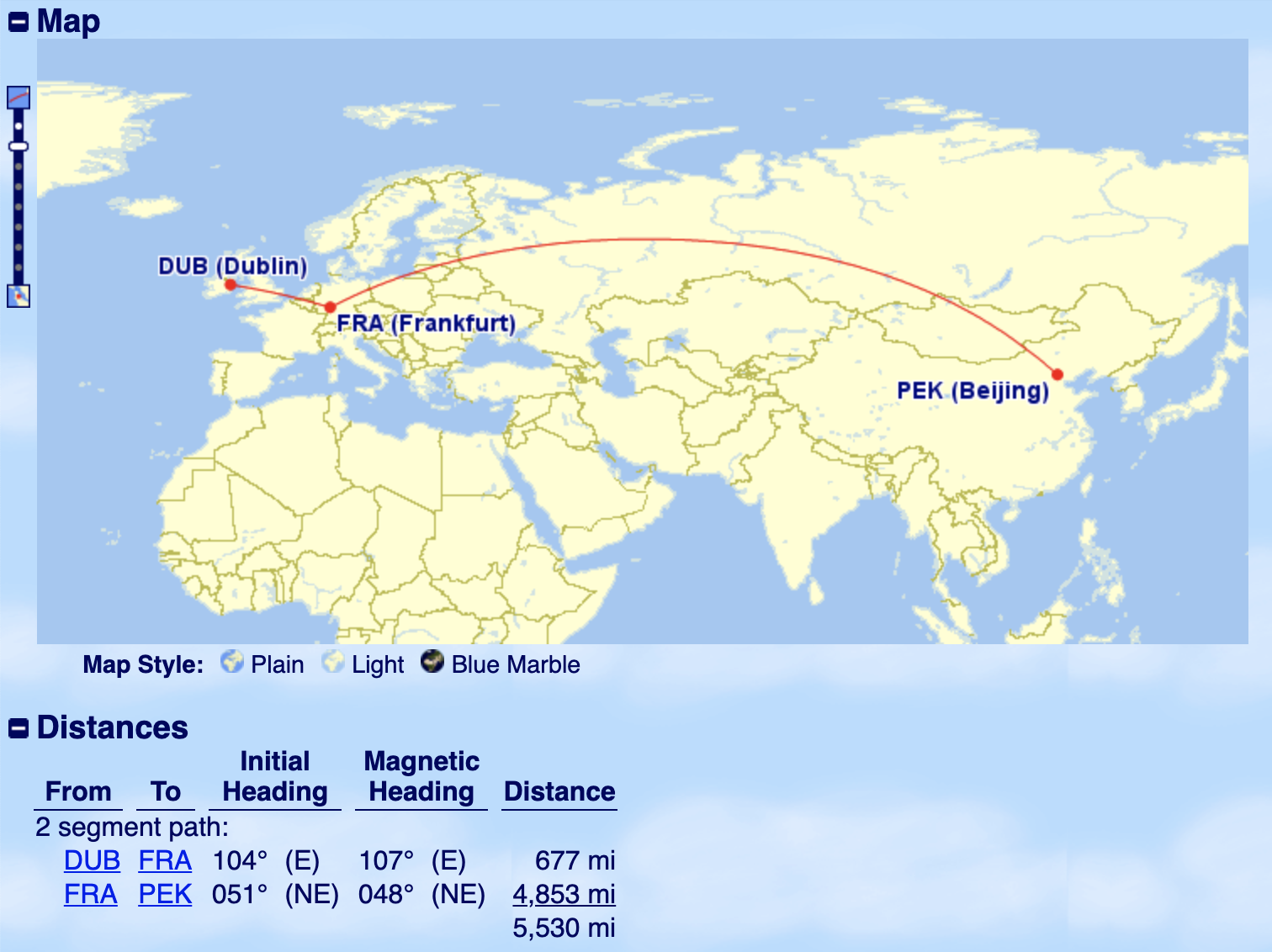
Booked as a single award, this would fall under the distance band of 5,001–7,000 miles on the “Between Atlantic and Pacific zones” chart, costing 85,000 Aeroplan points including the stopover.
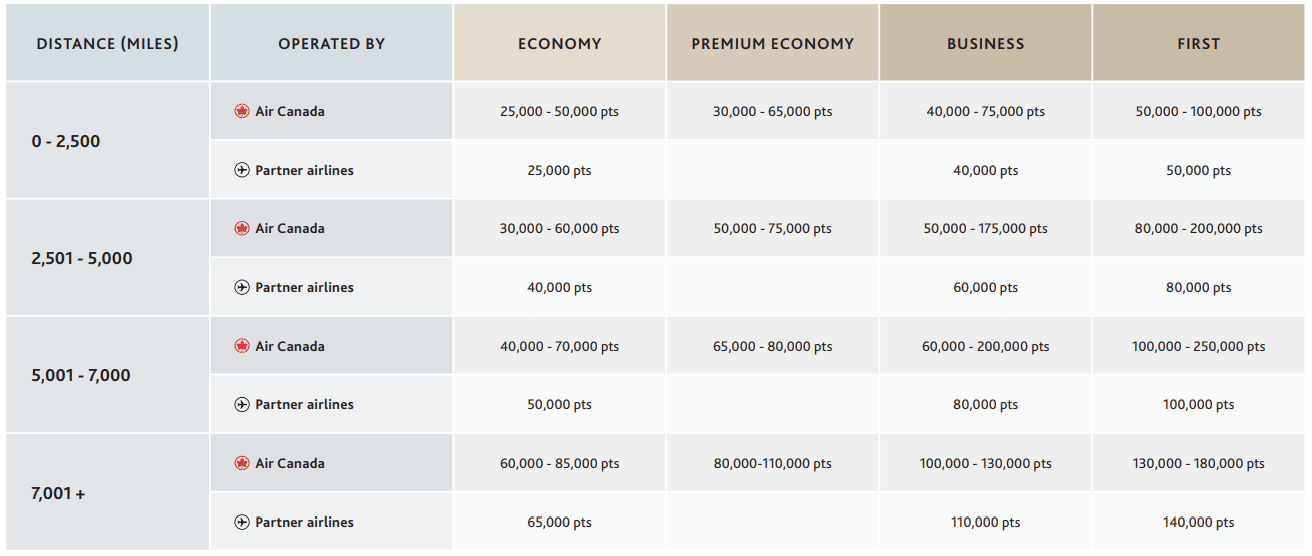
However, if we were to book this as two separate awards, then Dublin–Frankfurt would only cost 15,000 Aeroplan points on the “Within Atlantic zone” chart, while Frankfurt–Beijing would fall under the distance band of 0–5,000 miles on the “Between Atlantic–Pacific zones” chart, costing 60,000 Aeroplan points.
That’s a total of 75,000 Aeroplan points, a savings of 10,000 points compared to booking on a single award.
Atlantic/Pacific Arbitrage
One of the best, and most common, applications of strategic bound breaking can be seen when booking long-haul travel between North America and the Atlantic and Pacific zones.
Recall that there’s a noticeable difference in the relative generosities of the North America–Atlantic and North America–Pacific charts. In particular, pay attention to the distances permitted for the third and fourth distance bands.
On the “Between North America and Atlantic zones” chart, the third distance band covers flights between 6,001 and 8,000 miles, and the fourth distance band covers anything over 8,001 miles.

On the “Between North America and Pacific zones” chart, the third distance band covers flights between 7,501 and 11,000 miles, and the fourth distance band covers anything over 11,001 miles.
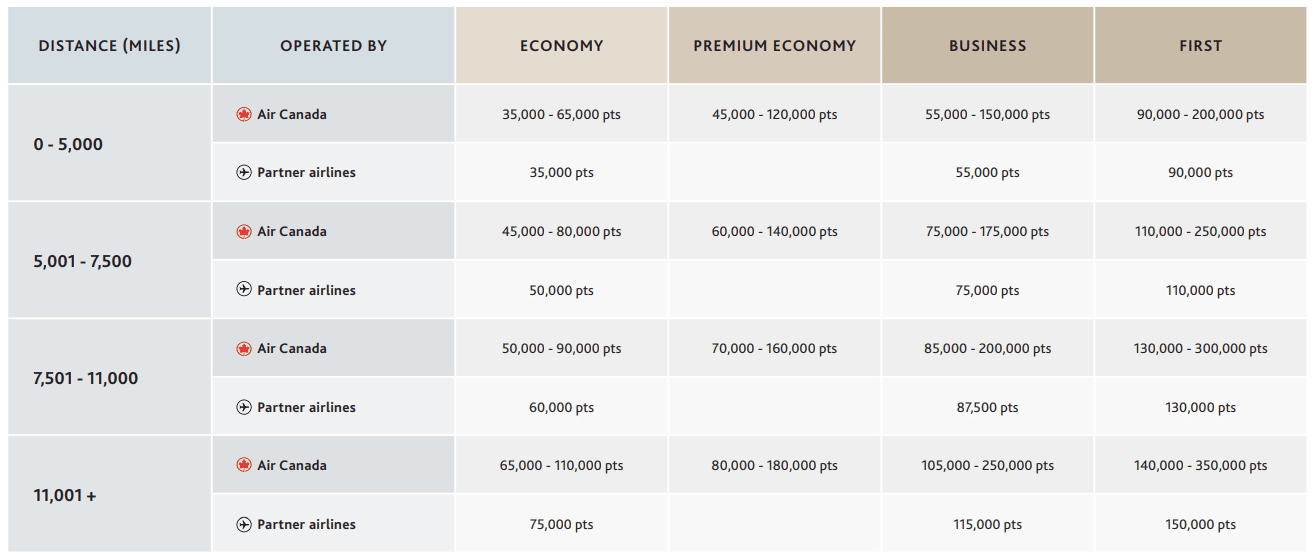
In other words, flights between North America and the Pacific zone have a much more generous distance allotment than flights between North America and the Atlantic zone. This is especially the case in the third distance band.
Since trips to the Pacific zone are allowed to route through the Atlantic zone, this opens up the possibility of leveraging these differences to your advantage – I like to call this “Atlantic/Pacific arbitrage”.
Let’s look at this practice through a series of examples.
Example 1: Maldives & Singapore
Any trip to the Atlantic zone that’s more than 8,000 miles will cost 70,000 or 110,000 Aeroplan points in economy or business class, respectively.
Trips to the Indian subcontinent and Central Asia, such as the below sample trip from Toronto to the Maldives, will most likely fall into this very expensive price range.

So, how can we soften this blow?
Well, by adding an additional flight into the Pacific zone, you can transform your North America–Atlantic redemption into a North America–Pacific one, and you’ll often end up saving points as a result!
In the above scenario, consider what would happen if we added an extraneous flight from the Maldives to Singapore…
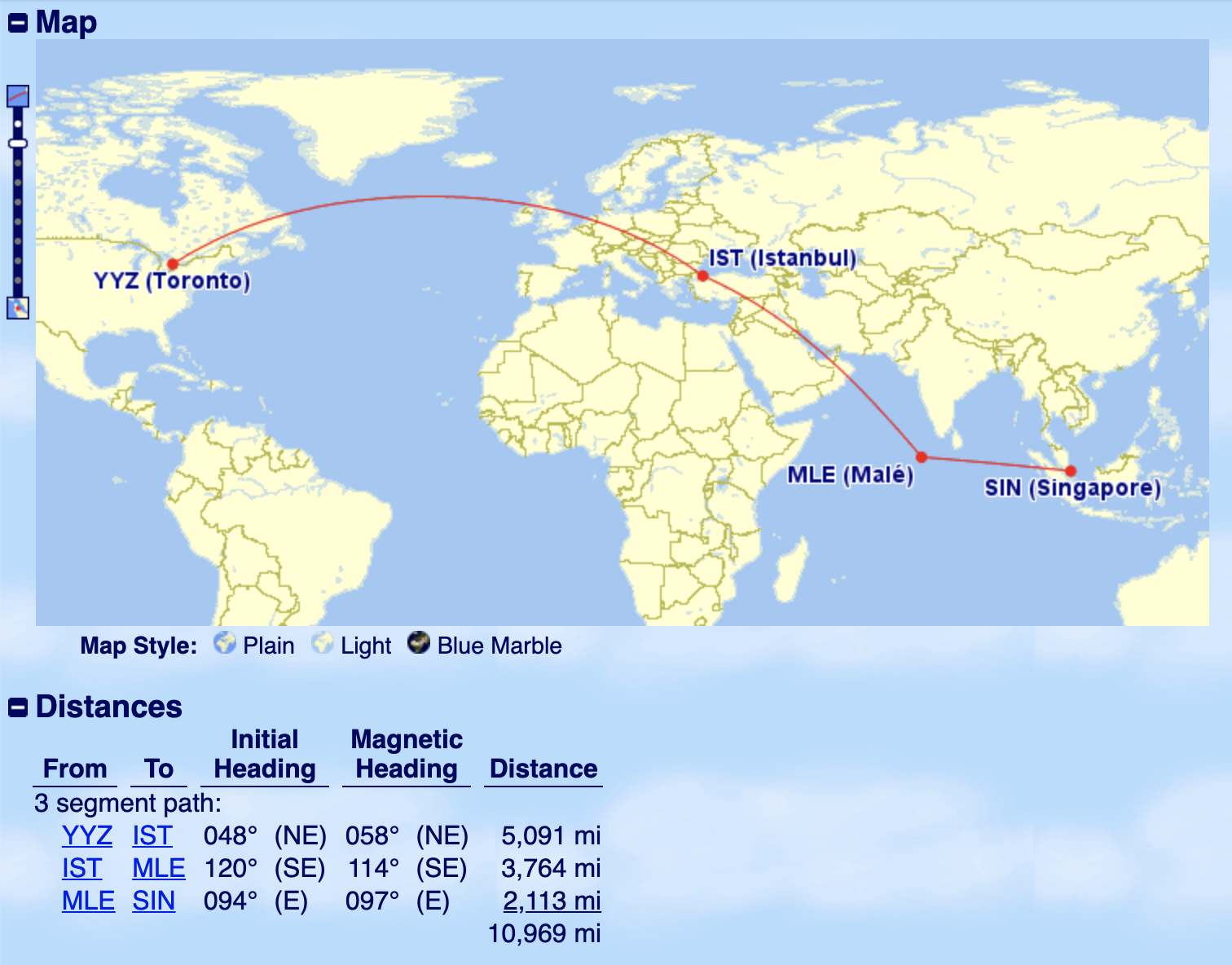
Since this is now a reward between Toronto and Singapore, it is governed by the North America–Pacific chart. And since the total distance clocks in under 11,000 miles, you’ll only pay 60,000 or 87,500 Aeroplan points in economy or business class for this whole thing.
And of course, since you actually wanted to go to the Maldives in the first place, we can add a stopover in the Maldives for 5,000 Aeroplan points, arriving at a total of 65,000 or 92,500 Aeroplan points.
This still results in savings compared to if we didn’t add the extra flight to Singapore in the first place.
Example 2: Central & East Asia
The same logic can be applied to any one-way redemption to most cities in the Indian subcontinent or Central Asia.
A redemption from Winnipeg to Almaty, a beautiful city in Kazakhstan, would cost a hefty 110,000 points…
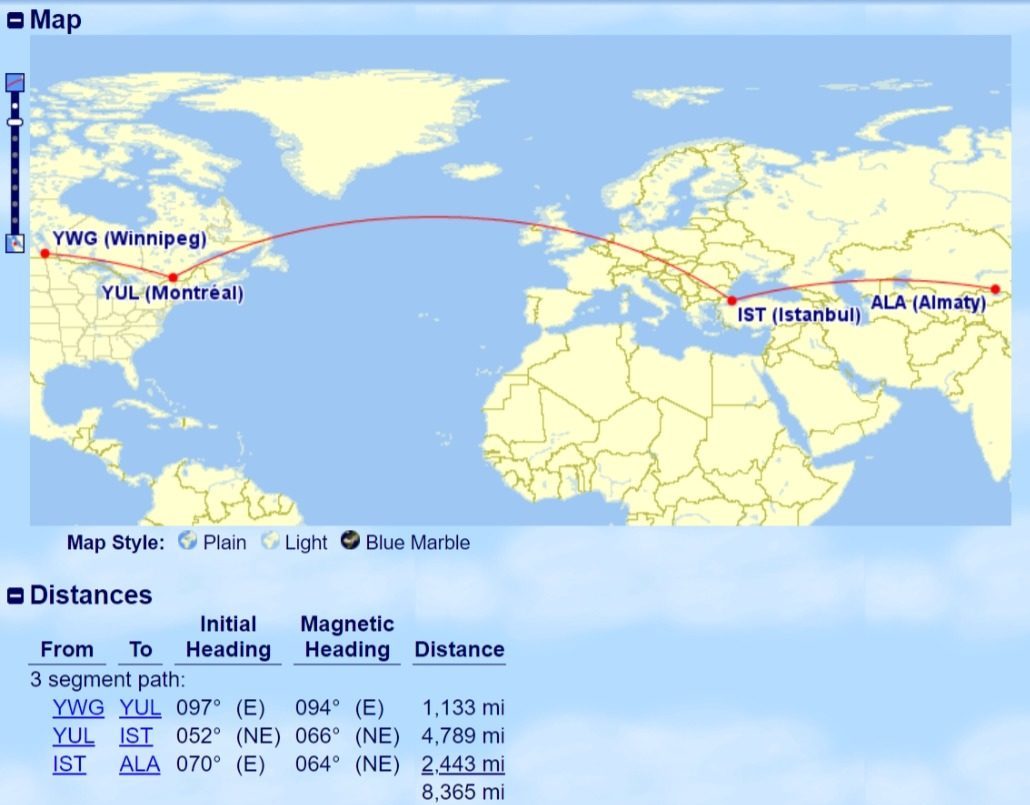
…but making Almaty your stopover, and tacking on an extraneous Asiana Airlines flight to Seoul, brings the cost down to 92,500 points.
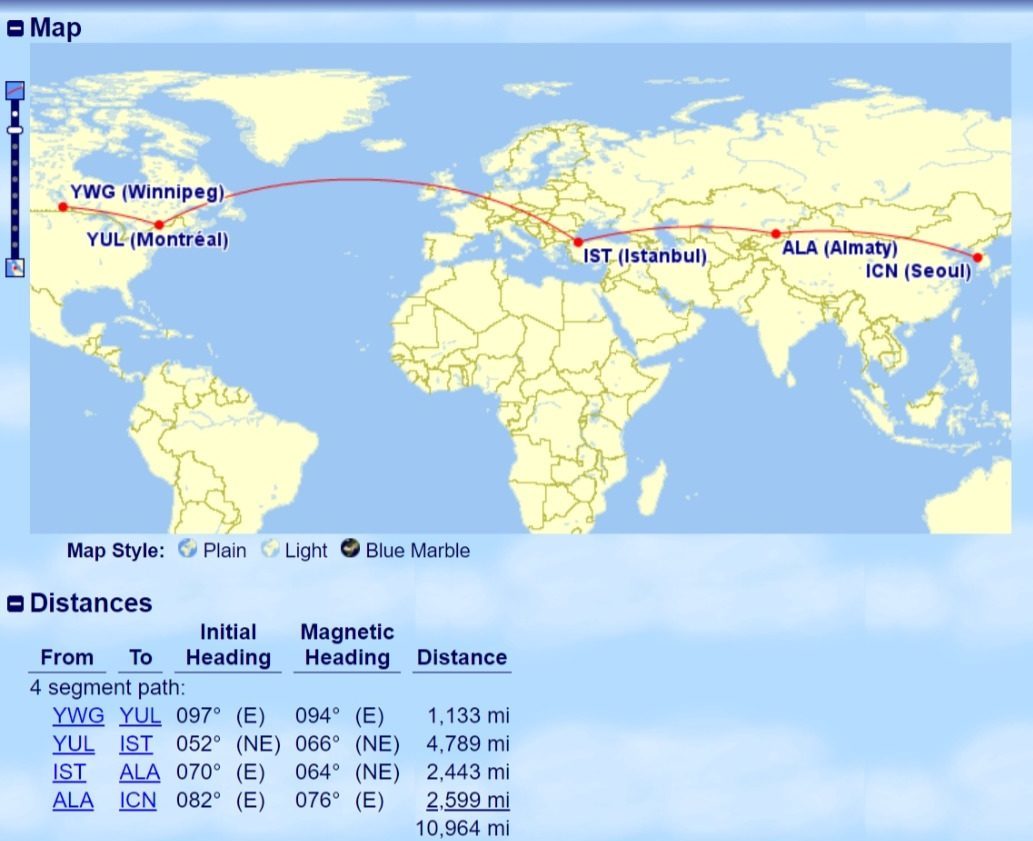
Example 3: From the West Coast
From Western Canada, you’ll have less room to play with in terms of the routing distance, but the Atlantic/Pacific arbitrage still works.
Here’s Vancouver to New Delhi for an unappealing 110,000 points…
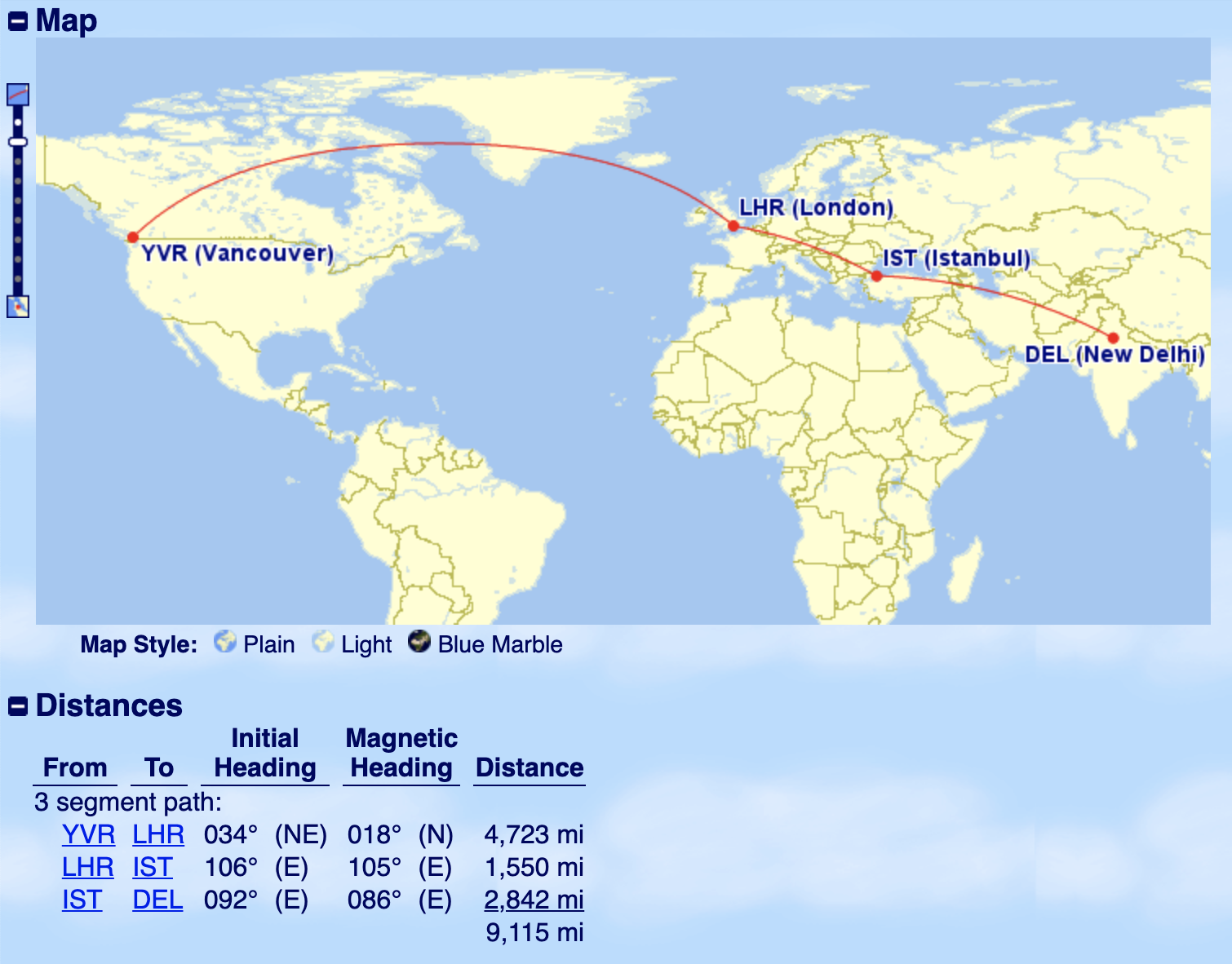
…but making it a stopover and adding an extra flight to Bangkok solves the problem (and just barely sneaks in under the 11,000-mile threshold).

Atlantic/Pacific arbitrage can help lower the price of one-way trips to destinations in the Atlantic zone as far west as Muscat, Oman (from select origin cities), going a long way towards softening the blow of the expensively-priced North America–Atlantic chart.
By adding a stopover in the Atlantic zone and making your destination in the Pacific zone, you can strategically save a tidy sum of Aeroplan points. As an added bonus, you’ll get to visit another part of the world while you’re at it.
Conclusion
Aeroplan’s complex logic for pricing out itineraries can take a while to fully understand. Knowing these rules, and using them to your advantage, can wind up saving you a number of Aeroplan points.
Understanding how to strategically break bounds is a savvy maneuver. While the practice doesn’t apply to all bookings, it’s important to play around with routings to see if you can possibly save some points.

















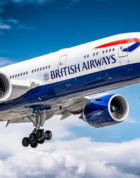

The online stopover booking tool just doesn’t seem to want to provide the J seats that are clearly available when 1) you try to book a simple one-way and 2) you look at the partner site.
Anyone really have any success booking stopovers using the online booking tool????
Yup. I gave up and just travelled out of the states. Nearly impossible. Tons of points but what’s the use? I wish I had stocked up more Delta, United and Alaska. See now Southwest is flying to Bellingham? Hnnn. Did anybody recently get a letter from “Mike” ? I fired him off a really nice letter-I hope he gets a raise for the great job he’s done so far at AC! Perhaps AC needs more bailout money to get more flights? It impressed with the lately! They suck!
All great in theory except for the past several months Aeroplan has been blatantly doing everything under the sun to get you on an Air Canada flight at insanely dynamically priced rates. I’ve searched, for example, Toronto to Tokyo, that came back with Toronto to Chicago on AC, then Chicago to Tokyo on United. But that little AC flight added on the dynamic insanity. So I searched for just Chicago to Tokyo to avoid the AC flight. Nope – search came back routing from Chicago BACK to Toronto, and then some other flights (don’t recall what, but definitely not the United flight from Chicago that the previous search had), thus applying the dynamic insanity.
What the eff is going on with Aeroplan? It’s virtually impossible, even breaking down simple searches even further by segment, to avoid getting a ridiculously priced AC flight forced down your throat (oh, and mostly mixed cabin at best)?
Hi Ricky. I am new to these Aeroplan tricks. I have been trying to read up on some of your strategies and they are very helpful. You are a saviour.
I was watching your route from YYZ to SIN with a stopover in the Maldives for only 85k plus 5k stop-over.
How do you book this? By phone?
I see I can do YYZ to SIN on the website one-way for 85K mixed cabin. Its not routing through IST and MLE.
I am hoping next year to have enough aeroplan points to plan a nice Asia or Europe business flight using my aeroplan points.
just realized istanbul-cairo redemption goes down from 85k return to 30k points in business. I think I am going to use it this year
Thank you very much Ricky.I thought I had it this time. lol But the silver lining In your logic is that it would cost me less then the current Aeroplan model. But of course this is dependant on getting the lowest band on the AC flights. Which I am hoping will not be an issue if I book early enough. And the savings of 800.00 in surcharges is also a huge incentive.
Ricky wasnt there Toronto-Morocco or Montreal-Morocco sweet spot somewhere in the new AP? From Morocco cross to Spain by boat or Ryanair and you are in Europe? Or just take Toronto-Dublin with Avios Aer Lingus and Ryanair then across Europe?
YUL-CMN or YUL-LIS-CMN is the sweet spot as Eric said. If you find YUL-CMN at the lower end of the AC pricing range, that’ll be an excellent deal.
I think you can do YYZ-LIS-CMN on TAP Portugal. There is a YUL-CMN route on AC but would stay away from it due to dynamic pricing
Why not just book two one ways instead of roundtrips all the times ? This would eliminate the ambiguity for where the bounds break and will provide more flexibily (open jaws) for the same pricing.
Three advantages to booking stuff on one PNR instead of separate PNRs:
1. Only pay one $39 partner fee.
2. Only pay one cancellation fee per ticket.
3. Apply a single Priority Rewards voucher for 50% off per ticket.
I think this case is when we’re using Priority Rewards since we can’t end up in the same airport. If we were to book two separate bookings with round trips you would have to use 2 priority rewards.
Ricky.
I think I have finally figured out how the new Aeroplan is going to work. Can you have a look at the practice trip and let me know if I calculated it correctly.
YYC to FRA 4692 miles
FRA to IST 1145 miles stop in IST
IST to TLV 696 miles
Total 6533 miles
TLV to VIE 1468 miles
VIE to FRA 388 miles
FRA to YYC 4692 miles
Total 6548 miles
I calculate it as 170,000 miles plus 5000 for the stopover in Istanbul total 175,000
But if I stop the bound at Istanbul and booked the IST to TLV as a second bound
and then the TLV to YYC as a third bound I would be able to get around the stopover charge and use only 170,00 miles.
Am I correct in my reasoning and calculations?
Also the 39.00 charge for partner airline booking is that for the entire trip or for each leg that
Is booked with partner airlines? In my example there is 2 legs with Turkish and 2 legs with Austrian Airlines. So would it be 39.00 or 156.00?
Almost, but not quite. If you booked it as three bounds, then you’d also have to pay 15,000 points for the IST-TLV bound as a “Within Atlantic zone” award.
The best way to book this would be to break the bound in IST, as outlined in the article above. That way, YYC-FRA-IST would come in just under 6,000 miles, so it would cost you 70,000 points. The return journey would still cost you 85,000 points, plus a stopover in TLV for 5,000 points, so in total you’d pay 160,000 points.
The $39 partner fee is per ticket, not per leg.
Hi Ricky,
Very clever routing – thanks for the idea!
If I’d book two separate (one way) ticket now, under the old aeroplan rules for a flight from YYZ to TLV with a hidden city in Europe1 in business – It will be only 110k miles for a bus class + very little taxes and fees if booked with TK or TAP. Then I could book another trip inside Europe with Economy.
I think it will be a much better deal.
Your thoughts?
Well, with hidden city, the outbound would be 55k, but the return wouldn’t be 55k unless you also originated in Europe 1. Nevertheless, it’ll be cheaper than post-Nov 8 either way.
Thanks Ricky for the input.
If I’d like to book a roundtrip YYZ-TLV with one stopover in OPO – should I do a bus fare YYZ-IST-OPO-YYZ as my roundtrip (OPO is a stopover and IST is my destination), and then wait for NOV 8 to book a roundtrip of IST-TLV IST in economy (I don’t have enough points for doing YYZ-TLV-OPO-YYZ all in bus)?
Or are there better options?
Thanks.
What would you suggest the best q
Routing be if I’m flying DEL-SMF under new program? I’m lost I can’t seem to understand the new logic
Something like SMF-SFO-YVR-DEL-BKK would allow you to take advantage of the Atlantic/Pacific arbitrage.
looks like new program is not all bad but add some opportunities as well, need to study and dig out some maximum value out of it while enjoying on the path…
You don’t mention using COPA airlines for trips to Uruguay and other South American destinations from Canada.
Any advice or suggestions?
Thanks
Travelling to the southern parts of South America doesn’t provide much room for clever strategies, I’m afraid. A trip from Canada to Uruguay, Argentina, Chile, or Brazil will definitely be at least 40,000/60,000 points in economy/business, since it’s going to exceed the 4,500-mile threshold for the South America chart. A stopover in Panama City for 5,000 points sounds like it could be fun, though.
I think the sweet spot for South America travel is primarily in using the “Within South America” chart to hop around the continent, as outlined here.
Are we really, *really* sure that “No Surcharges” applies to ALL flights with the new Aeroplan and not just Air Canada flights? Because I keep seeing language like “No cash surcharges.
We’re eliminating additional airline surcharges on flight rewards with Air Canada®, so you’ll pay less cash when you redeem, with no surprises at check‑out.” in today’s Aeroplan member email and it sure looks like they’re just eliminating it on AC flights, not others like LH.
Yes, we are *really* sure.
Remember, just because they only mention Air Canada, doesn’t mean they aren’t eliminating it on partners as well. The messaging focuses on Air Canada because 1) that’s what most Aeroplan members care about, and 2) that’s what Air Canada wants most Aeroplan members to care about.
Ricky, do you know if CX would be bookable on the new online platform? This would add more possible routes intra-SE Asia!
Yes, Cathay Pacific flights in South East Asia will be bookable online and combinable with Air Canada and other partners on the same ticket.
In fact, this is probably worth a post of its own at some point, since it’s something I’ve never covered before.
Damn you’re a good writer! You make things so clear! Sometimes I’ll read a paragraph and a question pops in my head, then bang! you address it in the next paragraph! Thanks for that.
Thanks, Louis! That’s always the goal.
Can someone explain why I would want to do #4? If there are no stopovers allowed in Canada/US, that means the maximum amount of time you can spend there is 24 hrs and when you reach home, you can only spend 24 hrs there as well before having to head out again. I suppose people with higher status who can use the priority rewards outside of Can/US will benefit from this as they can add stopovers.
JoeH is correct – while you can’t have stopovers on a one-way bound within Canada/US, the example in #4 doesn’t have any stopovers at all, it’s simply six one-ways put together on the same ticket (which is allowed). That lets you book three separate trips across the continent at different times over the course of a year, and apply the same 50% off voucher towards all three.
You’re allowed to link 6 one way trips into one ticket. So you can space the time between each arrival for months if you want. Fly to SFO and back to Toronto in November, then pick up to LA in March, and finish with a Seattle trip in June for example.
I figure it’s for those with a lot more stamina than I have for frequent flights and day trips outside of airports. Plus an intrinsic love of lounges + any amenities onboard status or credit cards would bring.
Personally for me the trip would be pure hell. But, if you actively like flights and airports, the the trip gets you:
* A 24 hour trip in three cities
* A bunch of free food in lounges and onboard, and the ability to try many lounges
* A bunch of different flights
Looking at the second itinerary specifically. I could see how this is enticing. I do like takeoff/landing, and day trips are great. I just….don’t think I could do it for ~5 days straight.
For Case #2.. (and if I am interpreting correctly) to force the bound to break at IST, I believe that T-Bayer could book two one ways. On the outbound, add a stopover somewhere in Europe for the same points, as long as the YQT-YYZ-Europe (stop)-IST destination is less than 6,000 miles. London, Paris, Rome etc. all would be options. The return one way would then be IST-TLV-YYZ-YQT.(destination)
Looking forward to unwrapping the new sweet spot possibilities with all.
Correct. The question is whether the search engine would be smart enough to price things accordingly if the user had simply entered IST and TLV as their proposed stops.
Can you explain the yvr-del part? What’s the benefit of adding bkk?
Ending in DEL costs 100,000 points. Making DEL a stopover, while adding an extra flight to BKK, costs 90,000 points.
Now I am getting excited.
The sweet spots are going to come out of the woodwork now.
This is what I have been waiting for.
Go to it Ricky, I will follow.
I am particularly interested in the Island Hopper.
The Island Hopper just got a whole lot more appealing for anyone who wishes to spend more than 24 hours on each island!
Miles & Pints in Pohnpei, anyone?
Ricky,
Not sure if I am calculating this one correctly. Will not be booking this until after Covid is done.
Calgary to Taipie 6199 miles
Taipei to Jakarta 2363 miles
Jakarta to Tokyo 2988 miles
Tokyo to Calgary 4968 miles
Total 16518 miles
So would it be 100,00 points in Business plus 15000 for three stopovers for a total of 115,000 points?
I feel I am all wet on this calculation.
JMA below is correct. In your calculation, you added up all the distances together and looked up that distance against the chart. But in fact it’ll need to be two separate calculations, since you’re booking a round-trip which is two “one-way bounds” – one for the outbound and one for the return.
Hi Dean,
Not sure where you will be stopping but if you do it at TPE and TYO as your stop, this will cost you 180,000 AP miles in J
YYC-TPE(stop)-CGK 85000 + 5000
CGK-TYO(stop)-YYC 85000 + 5000
AFAIK there is no direct flight from YYC-TPE, so you will need to transit to another city to catch a BR flight, that might increase the miles for AC flights.
As NRT-YYC is one of the sweetspot, it might be worth it to book that as a separate oneway if you can find at a saver level, and use avios from CGK-TYO.